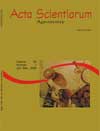<b>Application of industrial waste (silication) in red Argisoil of passion fruit cuttings</b> - DOI: 10.4025/actasciagron.v26i4.1714
Abstract
This work aims to evaluate the effect of silication calcium and industrial waste application to the production substratum of passion fruit cuttings as corrective material in the development, in the production of dry matter and in the nutritional plant state. The experimental design used randomized blocks of 5 treatments and 4 repetitions. The silicate calcium doses were applied in half; once, once and a half; and twice the dose to increase the V = 50%. These doses corresponding to 0.18; 0.36; 0.54; 0.72g dm-3, respectively. The cuttings received doses of N, P, K, Zn and B of 300; 450; 150; 5 and 0.5mg dm-3 respectively. The experimental unit was constituted of 2dm3 vases of a red Argissol substratum. Thus, the stem diameter, height, leaf number, dry matter production of the airy part of the roots, as well as the macro and micronutrients were evaluated after 80 days of the plantation. Thus, the silicate application to yellow-red Argisoil samples promoted quadratic increment in the height, stem diameter and in production of dry matter of passion fruit. The largest changes development was associated to the improvement of the soil fertility (saturation for bases = 57%; Ca = 20mmolc dm-3) and in the nutritional plants state (Ca - dry matter = 7.4g kg-1)Downloads
Download data is not yet available.
Published
2008-04-11
How to Cite
Prado, R. de M., & Natale, W. (2008). <b>Application of industrial waste (silication) in red Argisoil of passion fruit cuttings</b> - DOI: 10.4025/actasciagron.v26i4.1714. Acta Scientiarum. Agronomy, 26(4), 387-393. https://doi.org/10.4025/actasciagron.v26i4.1714
Issue
Section
Agronomy
DECLARATION OF ORIGINALITY AND COPYRIGHTS
I Declare that current article is original and has not been submitted for publication, in part or in whole, to any other national or international journal.
The copyrights belong exclusively to the authors. Published content is licensed under Creative Commons Attribution 4.0 (CC BY 4.0) guidelines, which allows sharing (copy and distribution of the material in any medium or format) and adaptation (remix, transform, and build upon the material) for any purpose, even commercially, under the terms of attribution.
2.0
2019CiteScore
60th percentile
Powered by 

2.0
2019CiteScore
60th percentile
Powered by 



















































